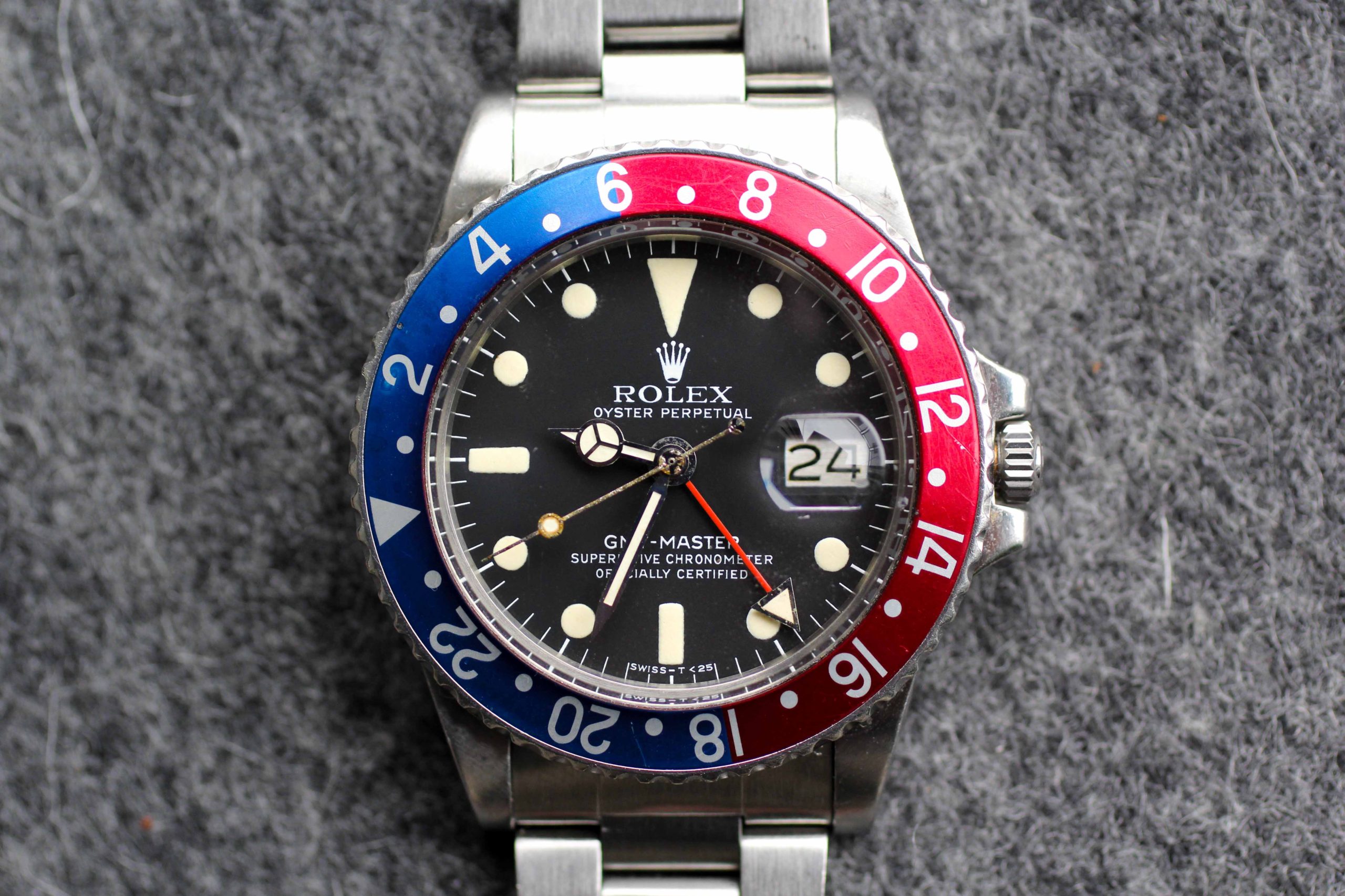Let’s start with an impossible exercise: pick the most iconic Rolex reference ever.
The most obvious contender is the Submariner. From the moment that Sean Connery wore a big crown Submariner on a 16mm NATO strap, it became the most revered (and copied) dive watch ever made. Another contender is the Daytona. The Paul Newman Daytona shattered the world record for the most expensive wristwatch ever, let alone most expensive Rolex, and has become synonymous with the burgeoning “investment class” of vintage watches. And then there’s the GMT Master. I doubt that many would say the GMT Master is the most iconic watch in Rolex’s illustrious historical catalog, but I think there’s a case to be made. Prior to the watch’s debut in 1954, there had never been another watch that functioned like the GMT Master (yes, that includes the Glycine Airman), and when one sees the vibrant “Pepsi” bezel from across a room, there’s no way to mistake the watch for something else. Aren’t those two of the most important elements in the creation of an icon?

As with other vintage Rolex sports models, the GMT Master continues to fascinate multiple generations of collectors, with a wide array of variants and a (mostly) linear design progression through the years. HODINKEE recently published an exhaustive study of the GMT Master in its Reference Points series (linked here) which lays out the model’s evolution and provides an essential resource for anyone thinking about purchasing a vintage GMT Master. For those who want to skip HODINKEE’s visual feast and just know the basics, however, I’ll provide a bit of context for my own watch.
The reference 1675 was introduced in 1959 as the successor to the reference 6542 and was produced until 1980, when it was succeeded by the reference 16750. For the first seven years of production, Rolex outfitted the 1675 with gilt gloss dials (such as this GMT Master that I previously owned), which were quite dynamic on the wrist but also prone to cracking or chipping of the gloss coating over time. In 1966, the GMT Master pivoted to matte dials and, with the exception of a Mk0.5 transitional model, a larger GMT hand. Once the matte dial era had arrived, design changes became continually more nuanced and the core DNA of the model remained essentially unchanged for the next 30 years.
If one scrolls through the lineup of GMT Masters in the Reference Points article, the visual difference between gilt and matte dial GMT Masters appears to be subtle. In the metal, however, the differences are stark. The lume plots, particularly in later 1675s, had a tendency to be puffier and have aged to creamy hues, which contrasts beautifully with the deep black color of the dial. My example, a Mk5, is the last iteration of the reference and is the distillation of nearly 20 years of tinkering. In fact, if you look quite closely at the Mk5 example in the Reference Points article, it looks a lot like my own (…because it is).

There are some watches that sit on my personal “want to buy list” for months or even years before I find them, but most watches enter my collection by pure chance. The story behind my purchase of this GMT Master isn’t remarkable and is one that I’ve written many times on this site, but for posterity, I’ll walk through it anyways. While browsing Rolex Forums one day, I noticed a thread from an owner who was asking about his old GMT Master. Typically, collectors pounce on posts such as this, but for some reason (likely because the owner had not uploaded pictures), the thread was mostly ignored. I sent the poster a private message offering to help him evaluate the watch, and to my delight, he responded almost immediately.
The seller was fairly knowledgeable about the market for 1675 GMTs and also provided helpful pictures (a rarity), and it was clear that a fair deal could be reached between the two of us. Ironically, it wasn’t until after I had already paid for the watch that I asked about the owner’s story, and it didn’t disappoint. In fact, this GMT Master has led a far more interesting life than just about any other watch that I own.

As it turned out, the original owner had served in the military and was able to provide an exact timeline of the watch’s history. While stationed at Spangdahlem Air Base in Germany as a member of the United States Air Force, he decided to buy a Rolex at the Base Exchange. Given the GMT Master’s tie to aviation, it was the most natural choice, and he immediately put the watch to use as his daily wearer. In the ensuing years, the watch faithfully ticked away as the owner piloted F-4 Phantoms in Germany, A-10 Warthogs in Arizona, and T-37s/C-5s at two other stations for the Air Force. Eventually, he transitioned to commercial aviation, and in 1995, the watch was also transitioned to a safety deposit box (see below for the watch’s full timeline).

The watch had picked up its fair share of dents and bruises over its 17 years, but ultimately the first phase of this GMT’s life was spent doing exactly what it was built to do for the exact type of person who needed it. Technology has largely replaced the need for watch complications in the modern era, so the idea of the purpose-built watch serving its purpose is oddly satisfying. While I will never become a fighter pilot myself, watches like this are why vintage watches retain their purity for even the most experienced and jaded collectors – no two watches age identically and the story behind the watch is just as meaningful as the watch itself.
After buying this 1675, I had the watch serviced for the first time in nearly 25 years and Phillip Ridley asked if I wanted to “restore” the case to its original beveled appearance. There are many collectors who would likely choose to improve the lone “flaw” with this watch, but in my opinion, the scratches and polished case tell the watch’s story better than I ever could. I opted to leave it as-is and will do my best to make the second chapter of this GMT’s life as interesting as I can. 
The Nitty Gritty
The example before you is a perfect way to learn what enthusiasts value most in a vintage GMT Master. The dial, which I believe to be the most important element of any vintage watch, is the definition of perfect. There is no damage or signs of wear, all lume plots match both in color and consistency, and the patina is a collector’s dream. The hands also remain in their original state with perfectly preserved patina, which helps to elevate this example from many other Mk5 GMT Masters. But now we arrive at the divisive elements.
The case has previously been polished and, while still thick, no longer bears its trademark beveled edges on the lugs. Additionally, the seconds hand is corroded (despite the lume remaining unaffected). Finally, the bezel (though original) retains its bright red and blue coloring and has not faded extensively, which is purely a matter of preference rather than value.
In my opinion, this represents the perfect daily wearing GMT Master. Visually, the watch has all the hallmarks of a top-tier example, but the limitations of the case will prevent it from ever becoming one, thus freeing a neurotic owner (such as myself) from babying the watch or relegating it to a bank vault for safekeeping.




